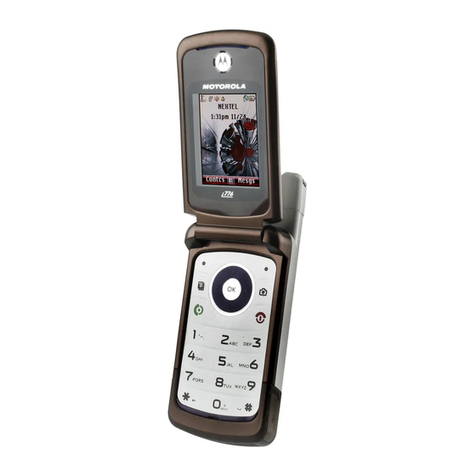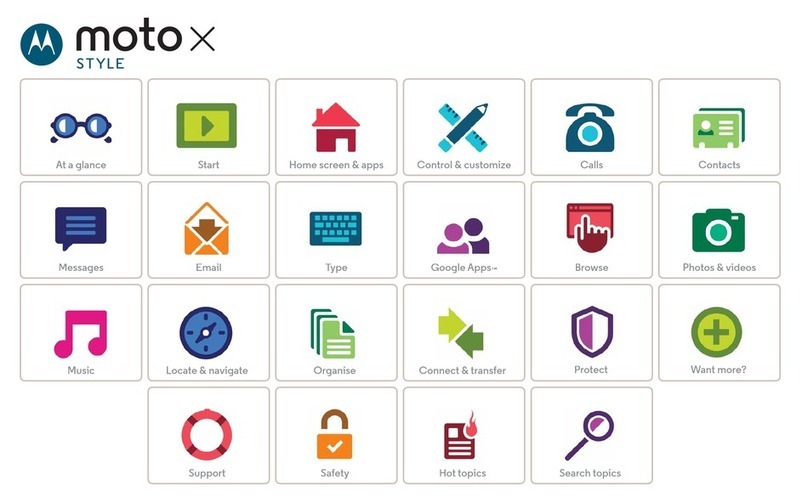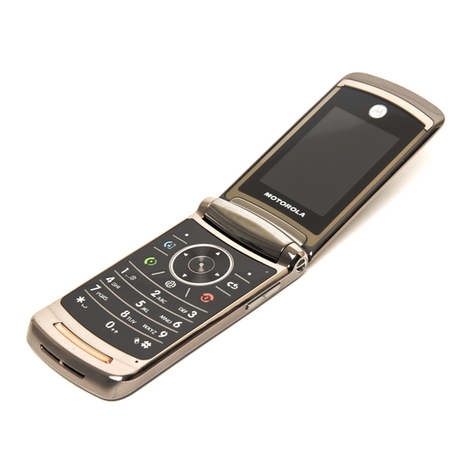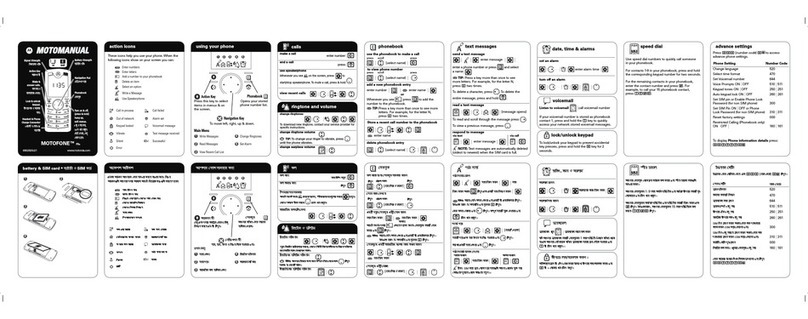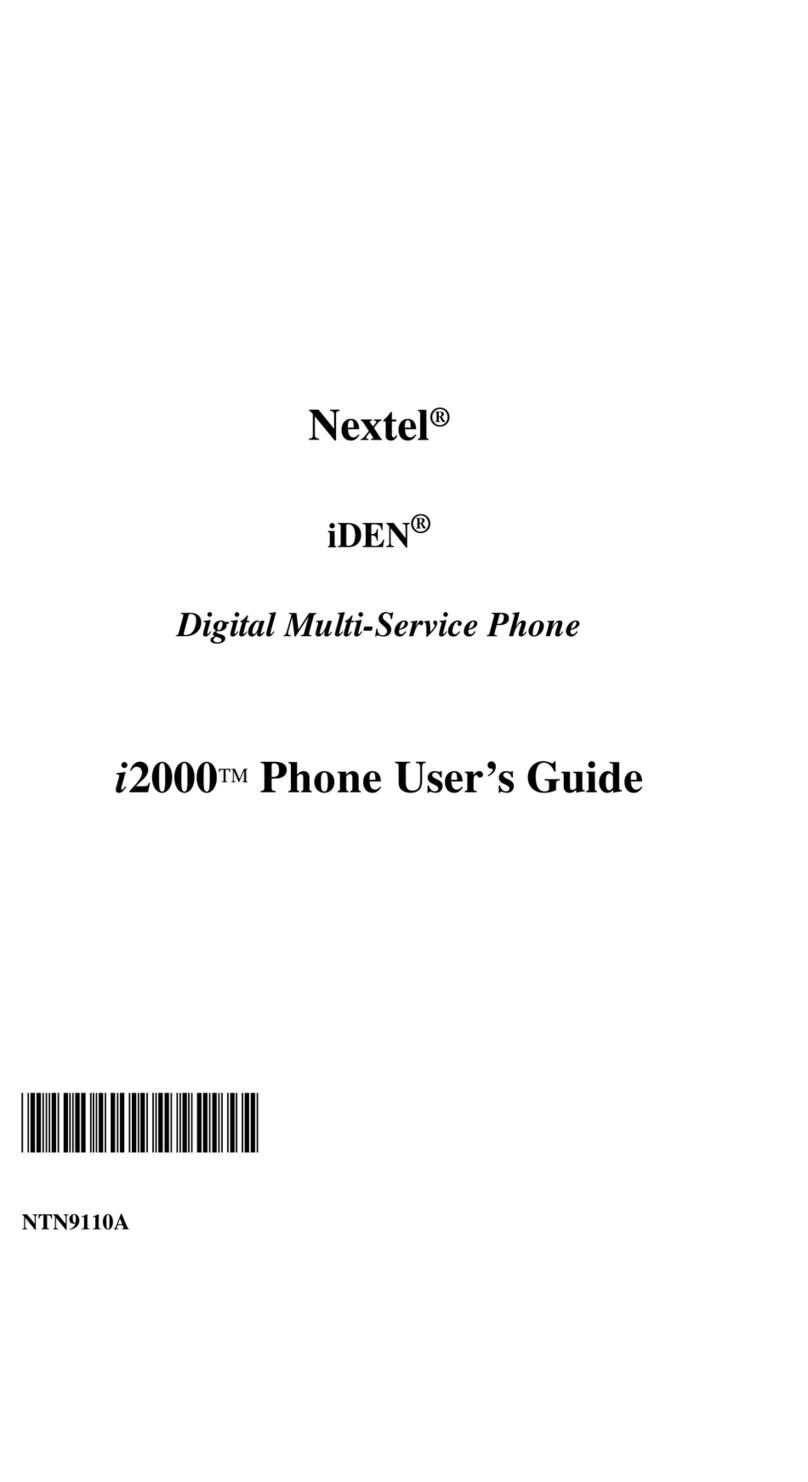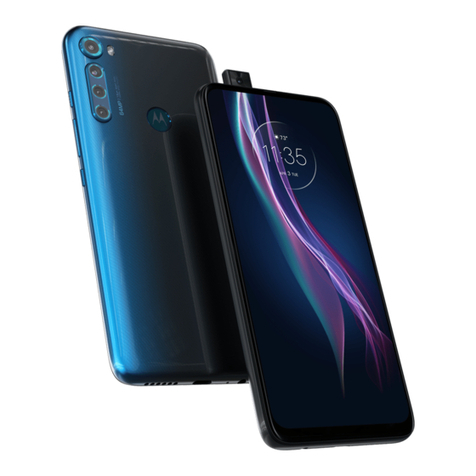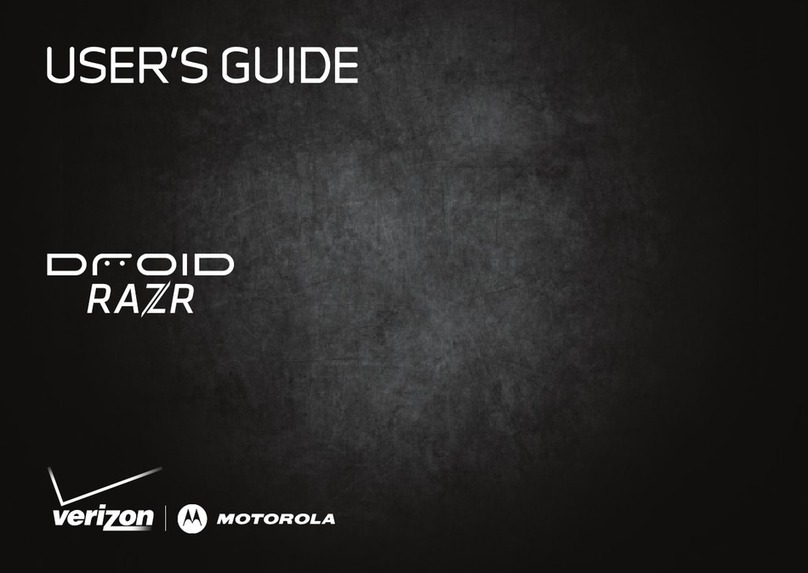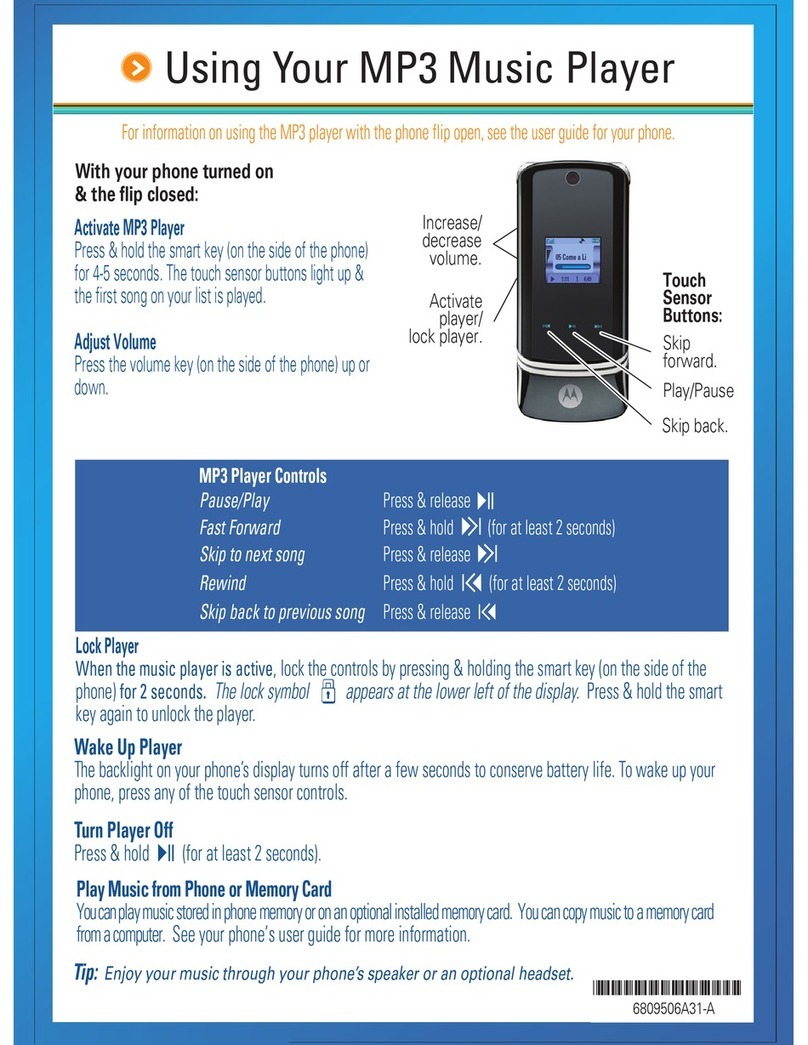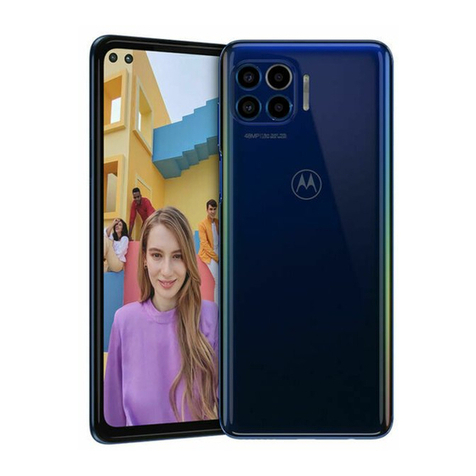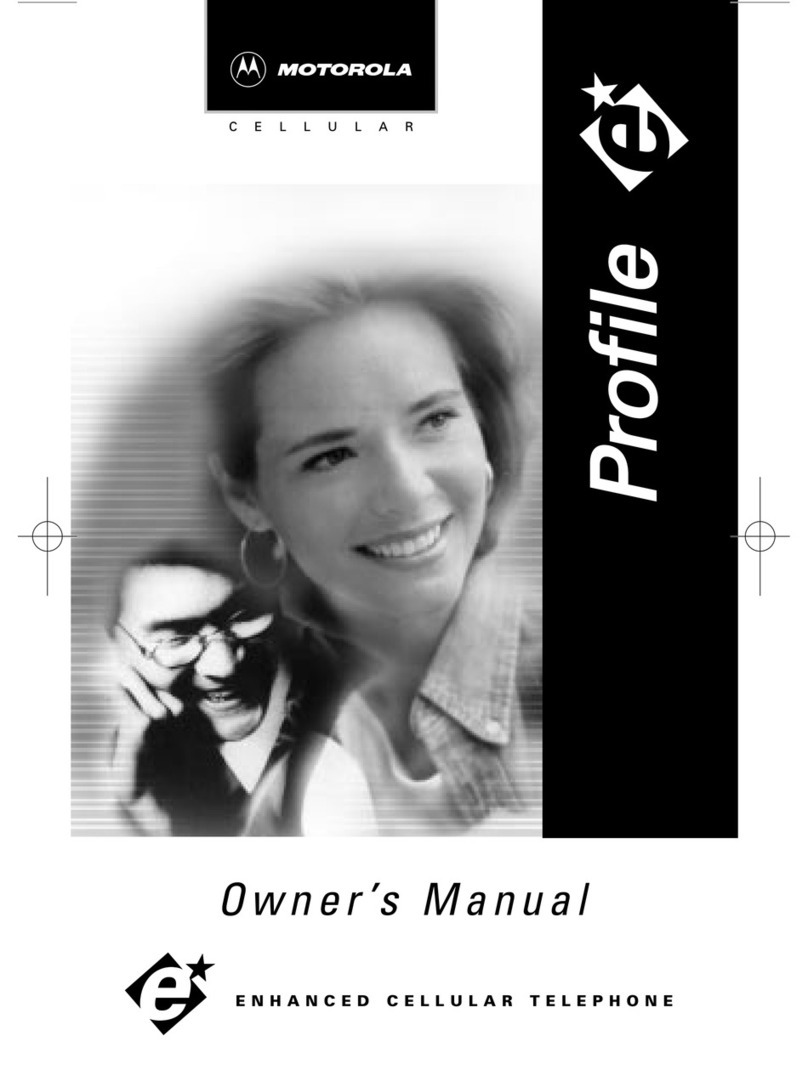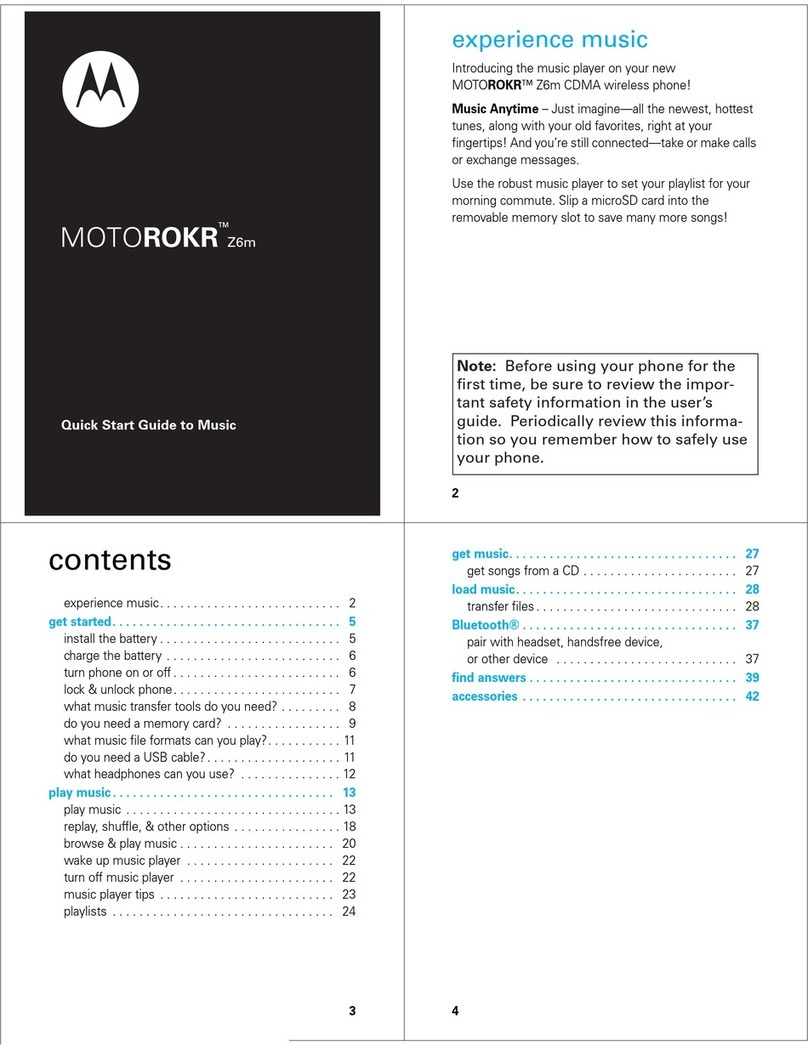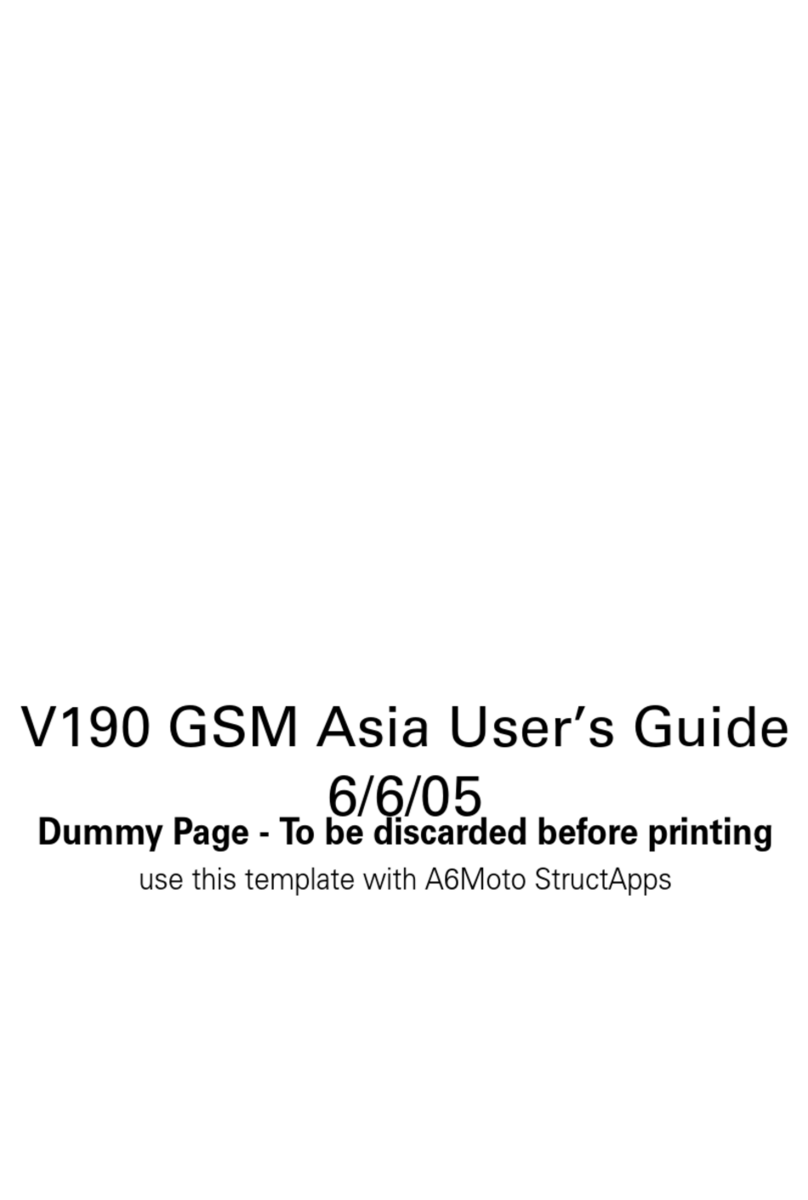FCC Notice to Users............
The following statement applies to all products that have received FCC
approval.Applicable products bear the FCC logo,and/or an FCC ID in the
format FCC-ID:xxxxxx on the product label.
Motorola has not approved any changes or modifications to this device by the user.
Any changes or modifications could void the user’s authority to operate the
equipment. See 47 CFR Sec. 15.21.
This device complies with part 15 of the FCC Rules. Operation is subject to the
following two conditions: (1) This device may not cause harmful interference, and (2)
this device must accept any interference received, including interference that may
cause undesired operation. See 47 CFR Sec. 15.19(3).
This equipment has been tested and found to comply with the limits for a Class B
digital device, pursuant to part 15 of the FCC Rules. These limits are designed to
provide reasonable protection against harmful interference in aresidential
installation.This equipment generates, uses and can radiate radio frequency energy
and, if not installed and used in accordance with the instructions, may cause harmful
interference to radio communications. However, there is no guarantee that
interference will not occur in a particular installation. If this equipment does cause
harmful interference to radio or television reception, which can be determined by
turning the equipment off and on, the user is encouraged to try to correct the
interference by one or more of the following measures:
• Reorient or relocate the receiving antenna.
• Increase the separation between the equipment and the receiver.
• Connect the equipment to an outlet on a circuit different from that to which the
receiver is connected.
• Consult the dealer or an experienced radio/TV technician for help.
Use & Care
To care for your Motorola phone, please keep it away from:
liquids of any kind
Don’t expose your phone to water, rain, extreme humidity, sweat, or
other moisture. If it does get wet, don’t try to accelerate drying with
the use of an oven or dryer, as this may damage the phone.
extreme heat or cold
Avoid temperatures below 0°C/32°F or above 45°C/113°F.
microwaves
Don’t try to dry your phone in a microwave oven.
dust and dirt
Don’t expose your phone to dust, dirt, sand, food, or other
inappropriate materials.
cleaning solutions
To clean your phone, use only a dry soft cloth. Don’t use alcohol or
other cleaning solutions.
the ground
Don’t drop your phone.
Information from the Worl d Health Organization
WHO Information Present scientific information does not indicate the need for any
special precautions for the use of mobile phones. If you are concerned, you may
want to limit your own or your children’s RF exposure by limiting the length of calls
or by using handsfree devices to keep mobile phones away from your head and
body. Source:WHO Fact Sheet 193
Further information: http://www.who.int/peh-emf
Caring for the Environment by Recycling
This symbol on a Motorola product means the product should not be
disposed of with household waste.
Disposal of your Mobile Device & Accessories
Please do not dispose of mobile devices or electrical accessories
(such as chargers, headsets, or batteries) with your household waste.
Do not dispose of your battery or mobile device in a fire.These items
should be disposed of in accordance with the national collection and
recycling schemes operated by your local or regional authority. Alternatively, you
may return unwanted mobile devices and electrical accessories to any Motorola
Approved Service Center in your region. Details of Motorola approved national
recycling schemes, and further information on Motorola recycling activities can be
found at: www.motorola.com/recycling
Disposal of your Mobile Device Packaging & Product uide
Product packaging and product guides should only be disposed of in accordance
with national collection and recycling requirements. Please contact your regional
authorities for more details.
Privacy & Data Security
Privacy & Data Security Motorola understands that privacy and data security are
important to everyone. Because some features of your mobile device may affect
your privacy or data security, please follow these recommendations to enhance
protection of your information:
•Monitor access—Keep your mobile device with you and do not leave it where
others may have unmonitored access. Lock your device’s keypad where this
feature is available.
•eep software up to date—If Motorola or a software/application vendor
releases a patch or software fix for your mobile device that updates the device’s
security, install it as soon as possible.
•Erase before recycling—Delete personal information or data from your mobile
device prior to disposing of it or turning it in for recycl ing. For instructions on how
to delete all personal information from your device, see your product guide.
Note:For information on backing up your mobile device data before erasing it, go
to www.motorola.com and navigate to the “downloads” section of the
consumer Web page for “Motorola Backup” or “Motorola Phone Too l s . ”
•Understanding AGPS —To provide location information for emergency calls,
certain Motorola mobile devices incorporate Assisted lobal Positioning System
(A PS) technology. A P S technology also can be used in non-emergency
applications to track and monitor a user’s location—for example, to provide
driving directions. Users who prefer not to permit such tracking and monitoring
should avoid using such applications.
If you have further questions regarding how the use of your mobile device may
impact your privacy or data security, please contact Motorola at
Smart Practices While Driving
Drive Safe, Call Smart
Check the laws and regulations on the use of mobile devices and their
accessories in the areas where you drive. Always obey them.The use of
these devices may be prohibited or restricted in certain areas—for
example, handsfree use only. Go to www.motorola.com/callsmart
(in English only) for more information.
Yo u r mobile device lets you communicate by voice and data—almost anywhere,
anytime, wherever wireless service is available and safe conditions allow. When
driving a car, driving is your first responsibility. If you choose to use your mobile
device while driving, remember the following tips:
•Get to know your Motorola mobile device and its features such as speed
dial and redial. If available , these features help you to place your call without
taking your attention off the road.
•Pos i t ion your mobile device within easy reach. Be able to
access your mobile device without removing your eyes from the
road. If you receive an incoming call at an inconvenient time, if
possible, let your voicemail answer it for you.
•Let the person you are speaking with know you are
driving; if necessary, suspend the call in heavy traffic or hazardous
weather conditions. Rain, sleet, snow, ice, and even heavy traffic can be
hazardous.
•Do not take notes or look up phone numbers while driving. Jotting down
a “to do” list or going through your address book takes attention away from your
primary responsibility—driving safely.
•Dial sensibly and assess the traffic; if possible, place calls when your car
is not moving or before pulling into traffic. If you must make a call while
moving, dial only a few numbers, check the road and your mirrors, then continue.
•Do not engage in stressful or emotional conversations that may be
distracting. Make people you are talking with aware you are driving and suspend
conversations that can divert your attention away from the road.
•Use your mobile device to call for help. Dial 911 or other local emergency
number in the case of fire, traffic accident, or medical emergencies (wherever
wireless phone service is available).
•Use your mobile device to help others in emergencies. If you see an auto
accident, crime in progress, or other serious emergency where lives are in danger,
call 911 or other local emergency number (wherever wireless phone service is
availab le), as you would want others to do for you.
•Call roadside assistance or a special non-emergency wireless assistance
number when necessary. If you see a broken-down vehicle posing no serious
hazard, a broken traffic signal, a minor traffic accident where no one appears
injured, or a vehicle you know to be stolen, call roadside assistance or other
special non-emergency wireless number (wherever wireless phone service is
availab le).
Motorola, Inc.
852-25063888 (H )
www.motorola.com.hk (H )
1-800-331-6456 (United States)
1-888-390-6456 (TTY/TDD United States for hearing impaired)
1-800-461-4575 (Canada)
Certain mobile phone features are dependent on the capabilities and
settings of your service provider’s network. Additionally, certain
features may not be activated by your service provider, and/or the
provider’s network settings may limit the feature’s functionality.Always
contact your service provider about feature availability and
functionality. All features, functionality, and other product
specifications, as well as the information contained in this guide, are
based upon the latest available information and believed to be
accurate at the time of printing. Motorola reserves the right to change
or modify any information or specifications without notice or
obligation.
MOTOROLA and the Stylized M Logo are registered in the US Patent
&Tr a d e m a r k Office. The Bluetooth trademarks are owned by their
proprietor and used by Motorola, Inc. under license. Java and all other
Java-based marks are trademarks or registered trademarks of Sun
Microsystems, Inc. in the U.S. and other countries. Microsoft,
Windows,Windows Me, and Windows Vista are registered trademarks
of Microsoft Corporation in the United States and other countries.
oogle,YouTube, Picasa, mail, and the oogle logo are trademarks of
oogle, Inc. All other product or service names are the property of
their respective owners.
© 2009 Motorola, Inc. All rights reserved.
Caution: Changes or modifications made in the radio phone, not
expressly approved by Motorola, will void the user’s authority to
operate the equipment.
Manual Number: CJB3146ALBZA
U.S. patent Re. 34,976
11 12 13 14 15 16
lass Parts
Some parts of your mobile device may be made of glass.This glass could break if the
product is dropped on a hard surface or receives a substantial impact. If glass breaks,
do not touch or attempt to remove. Stop using your mobile device until the glass is
replaced by a qualified service center.
Seizures/Blackouts
Some people may be susceptible to epileptic seizures or blackouts when exposed
to flashing lights, such as when playing video games. These may occur even if a
person has never had a previous seizure or blackout.
If you have experienced seizures or blackouts,or if you have a family history of such
occurrences, please consult with your physician before playing video games or
enabling a flashing-lights feature (if available) on your mobile device.
Discontinue use and consult a physician if any of the following symptoms occur:
convulsion, eye or muscle twitching, loss of awareness, involuntary movements, or
disorientation. It is always a good idea to hold the screen away from your eyes, leave
the lights on in the room, take a 15-minute break every hour, and stop use if you
are tired.
Caution About High Vol u m e Usage
War nin g: Exposure to loud noise from any source for extended
periods of time may affect your hearing. The louder the volume
sound level, the less time is required
before your hearing could be affected.To protect your hearing:
• Limit the amount of time you use headsets or headphones at high volume.
•Avoid turning up the volume to block out noisy surroundings.
•Tu r n the volume down if you can’t hear people speaking near you.
If you experience hearing discomfort, including the sensation of pressure or
fullness in your ears, ringing in your ears, or muffled speech, you should stop
listening to the device through your headset or headphones and have your hearing
checked. For more information about hearing, see our Web site at
www.motorola.com/hearingsafety (in English only).
Repetitive Motion
When you repetitively perform actions such as pressing keys or entering finger-
written characters, you may experience occasional discomfort in your hands, arms,
shoulders, neck, or other parts of your body. If you continue to have discomfort
during or after such use, stop use and see a physician.
[Jan0109]
17 18 19 20 21 22
Legal & Safety ......................
Battery Use & Safety
Important: Handle and store batteries properly to avoid injury or
damage. Most battery issues arise from improper handling of batteries, and
particularly from the continued use of damaged batteries.
DON’Ts
• Don’t disassemble, crush, puncture, shred, or otherwise attempt to
change the form of your battery.
•Don’t let the phone or battery come in contact with water. Water can
get into the phone’s circuits, leading to corrosion. If the phone and/or battery get
wet, have them checked by your carrier or contact Motorola, even if they appear
to be working properly.
•Don’t allow the battery to touch metal objects. If metal objects, such as
jewelry, stay in prolonged contact with the battery contact points, the battery
could become very hot.
•Don’t place your battery near a heat source. Excessive heat can damage
the phone or the battery. High temperatures can cause the battery to swell, leak,
or malfunction.Therefore:
• Do not dry a wet or damp battery with an appliance or heat source, such as a
hair dryer or microwave oven.
•Avoid leaving your phone in your car in high temperatures.
DOs
• Do avoid dropping the battery or phone. Dropping these items, especially
on a hard surface, can potentially cause damage.
•Do contact your service provider or Motorola if your phone or battery
has been damaged from dropping or high temperatures.
Important: Use products provided by Motorola box set for quality
assurance and safeguards.
NOTE: Some mobile phones may contain a non Motorola-branded battery when
purchased. Those batteries are designed for use with your phone. If a replacement
is needed, only the type and model that came with your phone are recommended
for use Please contact authorized dealer for any enquiries.
Important: Refer to Motorola's warranty for details of coverage and exclusions.
War nin g: Use of an improper battery or charger may present a risk of fire,
explosion, leakage, or other hazard.
Proper and safe battery disposal and recycling: Proper battery disposal is not
only important for safety, it benefits the environment. Consumers may recycle their
used batteries in many retail or service provider locations.Additional information on
proper disposal and recycling may be found on the We b :
• www.motorola.com/recycling
• www.rbrc.org/call2recycle/ (in English only)
Disposal: Promptly dispose of used batteries in accordance with local
regulations. Contact your local recycling center or national recycling
organizations for more information on how to dispose of batteries.
War nin g: Never dispose of batteries in a fire because they may
explode.
Battery Charging
Notes for charging your phone’s battery:
• When charging your battery, keep it near room temperature.
Never expose batteries to temperatures below 0°C (32°F) or above 45°C (113°F)
when charging.
• New batteries are not fully charged.
• New batteries or batteries stored for a long time may take more time to charge.
Specific Absorption Rate
Yo u r model wireless phone meets international guidelines for exposure
to radio waves.
Yo u r mobile device is a radio transmitter and receiver. It is designed to not exceed
the limits for exposure to radio waves recommended by international guidelines.
These guidelines were developed by the independent scientific organization ICNIRP
and include safety margins designed to assure the protection of all persons,
regardless of age and health, and to account for any variations in measurements.
The guidelines use a unit of measurement known as the Specific Absorption Rate
(SAR).The ICNIRP SAR limit for mobile devices used by the general public is 2 watts
per kilogram (W/kg), and the highest SAR value for this mobile device when tested
at the ear is 1.24W/kg.As mobile devices offer a range of functions, they can be used
in other positions, such as on the body as described in this guide. In this case, the
highest tested SAR value is 1.26 W/kg.The tests are carried out in accordance with
international guidelines for testing. The SAR information includes the Motorola
testing protocol, assessment procedure, and measurement uncertainty range for this
product.
As SAR is measured utilizing the mobile device’s highest transmitting power, the
actual SAR of this mobile device while operating is typically below that indicated
above.This is due to automatic changes to the power level of the mobile device to
ensure it only uses the minimum level required to reach the network.
normal, non-exclusive, royalty-free license to use that arises by operation of law in
the sale of a product.
Safety & General Information
This section contains important information on the safe and efficient
operation of your mobile device. Read this information before using
your mobile device.
Exposure to Radio Frequency (RF) Energy
Yo u r mobile device contains a transmitter and receiver.When it is ON, it receives
and transmits RF energy.When you communicate with your mobile device, the
system handling your call controls the power level at which your mobile device
transmits.Your mobile device is designed to comply with local regulatory
requirements in your country concerning exposure of human beings to RF energy.
Operational Precautions
For optimal mobile device performance, and to be sure that human exposure to
RF energy does not exceed the guidelines set forth in the relevant standards,
always follow these instructions and precautions.
Product Operation
When placing or receiving a phone call, hold your mobile device just like you
would a landline phone.
If you wear the mobile device on your body, always place the mobile device in a
Motorola-supplied or approved clip, holder, holster, case, or body harness. If you do
not use a body-worn accessory supplied or approved by Motorola, keep the
mobile device and its antenna at least 2.5 centimeters (1 inch) from your body
when transmitting.
Using accessories not supplied or approved by Motorola may cause your mobile
device to exceed RF energy exposure guidelines. For a list of Motorola-supplied or
approved accessories, visit our We b site at: www.motorola.com.
RF Energy Interference/Compatibility
Nearly every electronic device is subject to RF energy interference from external
sources if inadequately shielded, designed, or otherwise configured for RF energy
compatibility. In some circumstances, your mobile device may cause interference
with other devices.
Follow Instructions to Avoid Interference Problems
Tu r n off your mobile device in any location where posted notices instruct you to
do so.
In an aircraft, turn off your mobile device whenever instructed to do so by airline
staff. If your mobile device offers an airplane mode or similar feature, consult irline
staff about using it in flight.
Implantable Medical Devices
If you have an implantable medical device, such as a pacemaker or defibrillator,
consult your physician before using this mobile device.
Persons with implantable medical devices should observe the following recautions:
• ALWAYS keep the mobile device more than 20 centimeters (8 inches) from the
implantable medical device when the mobile device is turned ON.
• DO NOT carry the mobile device in the breast pocket.
• Use the ear opposite the implantable medical device to minimize the potential
for interference.
•Tu r n OFF the mobile device immediately if you have any reason to suspect that
interference is taking place.
Read and follow the directions from the manufacturer of your implantable medical
device. If you have any questions about using your mobile device with your
implantable medical device, consult your healthcare provider.
Driving Precautions
The use of wireless phones while driving may cause distraction. Discontinue a call
if you can’t concentrate on driving.
Additionally, the use of wireless devices and their accessories may be prohibited or
restricted in certain areas.Always obey the laws and regulations on the use of
these products.
Responsible driving practices can be found in “Smart Practices While Driving.”
Operational Warnings
Obey all posted signs when using mobile devices in public areas.
Potentially Explosive Atmospheres
Areas with potentially explosive atmospheres are often, but not always, posted and
can include fueling areas, such as below decks on boats, fuel or chemical transfer
or storage facilities, or areas where the air contains chemicals or particles, such as
grain dust, or metal powders.
When you are in such an area, turn off your mobile device, and do not remove,
install, or charge batteries. In such areas, sparks can occur and cause an explosion
or fire.
Symbol Key
Yo u r battery, charger, or mobile device may contain symbols, defined as follows:
Batteries & Chargers
Caution: Improper treatment or use of batteries may present a danger of fire,
explosion, leakage, or other hazard. For more information, see “Battery Use &
Safety.”
Keep Yo u r Mobile Device and Its Accessories
Away From Small Children
These products are not toys and may be hazardous to small children. For example:
• A choking hazard may exist for small, detachable parts.
• Improper use could result in loud sounds, possibly causing hearing injury.
• Improperly handled batteries could overheat and cause a burn.
While there may be differences between the SAR levels of various mobile devices
and at various positions, they meet the governmental requirements for safe
exposure. Please note that improvements to this product model could cause
differences in the SAR value for later products; in all cases, products are designed to
be within the guidelines.
The World Health Organization has stated that present scientific information does
not indicate the need for any special precautions for the use of mobile devices.They
note that if you want to reduce your exposure, then you can do so by limiting the
length of calls or using a handsfree device to keep the mobile device away from the
head and body.
Additional Information can be found on the We b sites of the Wo r l d Health
Organization (http://www.who.int/emf) or Motorola, Inc.
(http://www.motorola.com/rfhealth).
European Union Directives
Conformance Statement
Hereby, Motorola declares that this product is in compliance
with:
• The essential requirements and other relevant provisions of
Directive 1999/5/EC
• All other relevant EU Directives
The above gives an example of a typical Product Approval Number.
Yo u can view your product’s Declaration of Conformity (DoC) to Directive
1999/5/EC (to R&TTE Directive) at www.motorola.com/rtte. To find your DoC,
enter the Product Approval Number from your product’s label in the “Search” bar
on the We b site.
Software Copyright Notice
Motorola products may include copyrighted Motorola and third-party software
stored in semiconductor memories or other media. Laws in the United States and
other countries preserve for Motorola and third-party software providers certain
exclusive rights for copyrighted software, such as the exclusive rights to distribute
or reproduce the copyrighted software. Accordingly, any copyrighted software
contained in Motorola products may not be modified, reverse-engineered,
distributed, or reproduced in any manner to the extent allowed by law. Furthermore,
the purchase of Motorola products shall not be deemed to grant either directly or
by implication, estoppel, or otherwise, any license under the copyrights, patents, or
patent applications of Motorola or any third-party software provider, except for the







